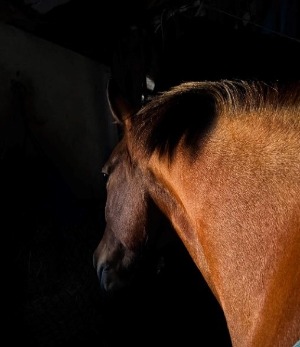Integrating genetics with functional genomics to dissect the aetiopathogenesis of equine exertional rhabdomyolysis

Equine exertional rhabdomyolysis (ER) is a syndrome involving painful, exercise induced episodes of muscle stiffness and acute myonecrosis which can result in renal failure and in severe cases, death.
While it is seen in many different species from humans to dogs, horses seem to be particularly predisposed. In thoroughbreds an incidence rate as high as ~5% of the population has been reported. Moreover, other pleasure horses are predisposed to the disease, in particular Warmbloods. It is known that there is a genetic component affecting ER susceptibility (h2=0.34-0.49), meaning it can be passed on from parent to offspring. However, the environment still has an important role in the occurrence of the syndrome with factors such as diet, behaviour and sex playing a role in whether a horse will develop an ER episode. We have shown previously that ER has distinct subgroup phenotypes and that these have a distinct genetic background, with the majority of the genomic markers associated with the disease located in non-coding regions of the genome.
Research has already shown that ER primarily affects muscles rich in Type 2 (fast oxidative and fast glycolytic) fibre types. We are interested in answering why these fibre types are mostly affected.

Based on our previous research we hypothesis that ER is a heritable complex trait, that there are distinct regulatory genomic regions that are active in muscles with primarily oxidative or glycolytic function and in the case of ER that there is regulatory region dysfunction mainly in glycolytic muscles. Now, we have a new iCASE studentship with which aims to investigate these hypotheses using a multi-omics (merging genomics, transcriptomics, epigenetics and 3D genomics) approach. We hope to gain more of an understanding of how ER occurs and why, enabling us to discover better ways of managing the condition, develop epigenetic tools with predictive capacity in order to improve horse health and welfare, and help them to continue to compete to the full extent of their abilities.
Charlotte Cuffe is the PhD student undertaking this project, supervised by Dr Androniki Psifidi, Professor Richard Piercy and (Roslin Institute, University of Edinburgh). It is an iCase studentship with Holos Life Sciences Ltd.
You may also be interested in:
-
New research from the RVC predicts the future life expectancy for companion cats
New research from the °ÄĂĹÁůşĎ˛ĘąćÂÉÂŰĚł (RVC), in collaboration with researchers from the …

